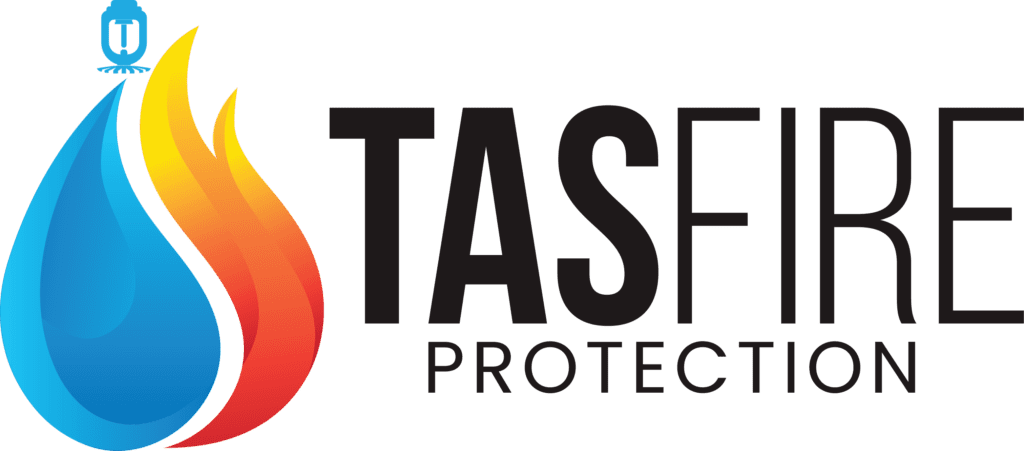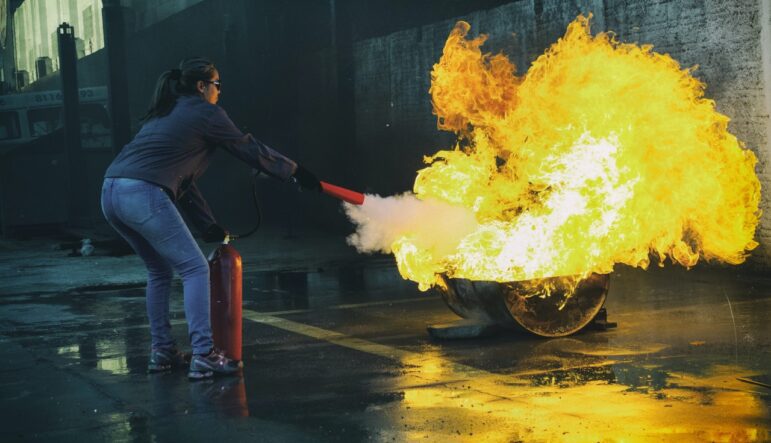How to Operate a Fire Extinguisher?…
A fire extinguisher could save your life if you know how to use it. When using a fire extinguisher, you must first decide whether or not it is safe for you to battle the fire and whether or not you are capable of extinguishing the fire completely. Evacuate the building immediately and call the fire department if you don’t think you can put out the fire on your own. Before we understand the process of operation of the fire extinguishers, let us understand what a fire extinguisher is and what the different types of fire extinguishers are.
What Is a Fire Extinguisher?
Fire extinguishers can be used as portable equipment to put out small flames before firemen arrive. Fire extinguishers can be found at various locations, such as in buildings, factories, public transportation, and more. A location’s safety rules determine the types and numbers of extinguishers that are legally necessary.
What Are the Types of Fire Extinguishers?
Depending on the type of fire extinguisher services, there are six variants available. They’re used for a variety of purposes.
- Water: unbreakable fire
- Foam (aqueous film-forming foam (AFFF)): solid and liquid fires.
- Carbon dioxide (CO2): solid, liquid, gas, oil, fat, and electric fires.
- Dry chemical powder: solid, liquid, gas, oil, fat, and electric fires.
- Wet chemicals: solid, oil, and fat fires.
- Vaporizing liquid: solid, liquid, gas, and electric fires.
Cylinders of extinguishing agents are filled with compressed air, gas, or chemicals that release gas when activated. To use the extinguisher, the user must first remove the safety lock and then pull the trigger or handle.
Water-Fire Extinguisher
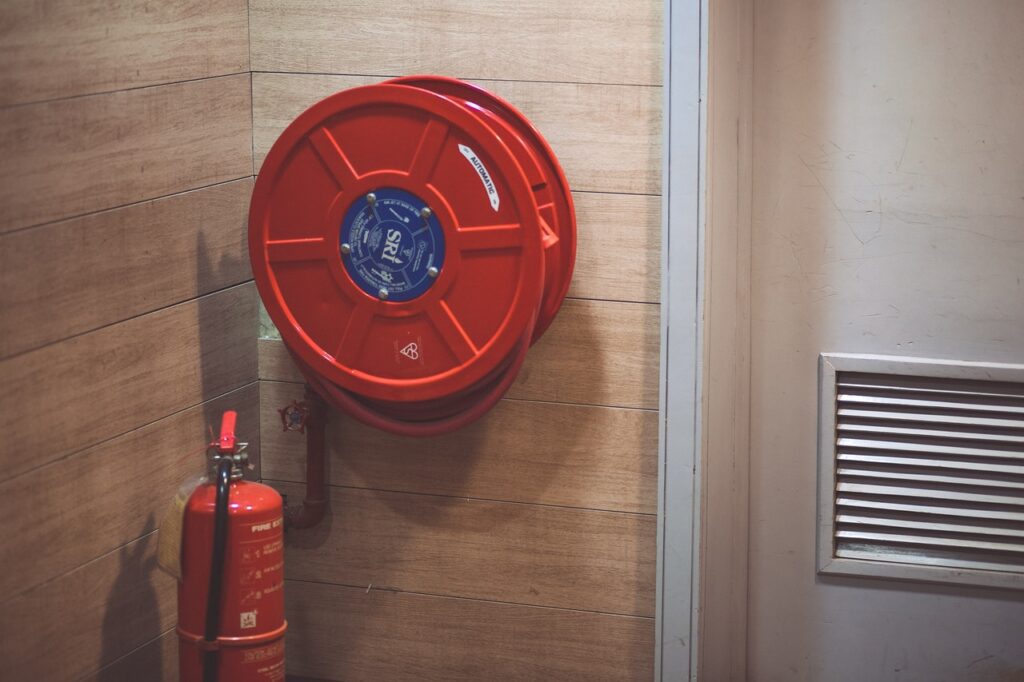
Using water extinguishers to put out Class A fires is one of the most cost-effective ways to do it. Water jets, water sprays, water with additives, and water mist or fog are the four main forms of water extinguishers. Water jet extinguishers cool and prevent re-ignition by squirting a jet of water at the flames. Using them on live electrical equipment is not recommended.
To put out a fire, water spray extinguishers spray an extremely fine mist of water droplets surrounded by impermeable air.
Water extinguishers with foaming chemicals added are known as water extinguishers with additives. Burning elements are more easily absorbed by the water because it loses their natural surface tension. For a fire extinguisher to be effective, it must have the same fire rating as a bigger water-only extinguisher.
Extinguishers using water mist or fog apply water in a mist or fog, and the droplets are smaller than those from water spray. Two factors that affect how quickly a water droplet evaporates are the droplet’s surface area and the droplet’s volume. As a tiny droplet weighs less, the cloud of water it creates is weaker.
A red label can be found on every water extinguisher.
You may also like to read:
Foam Fire Extinguisher
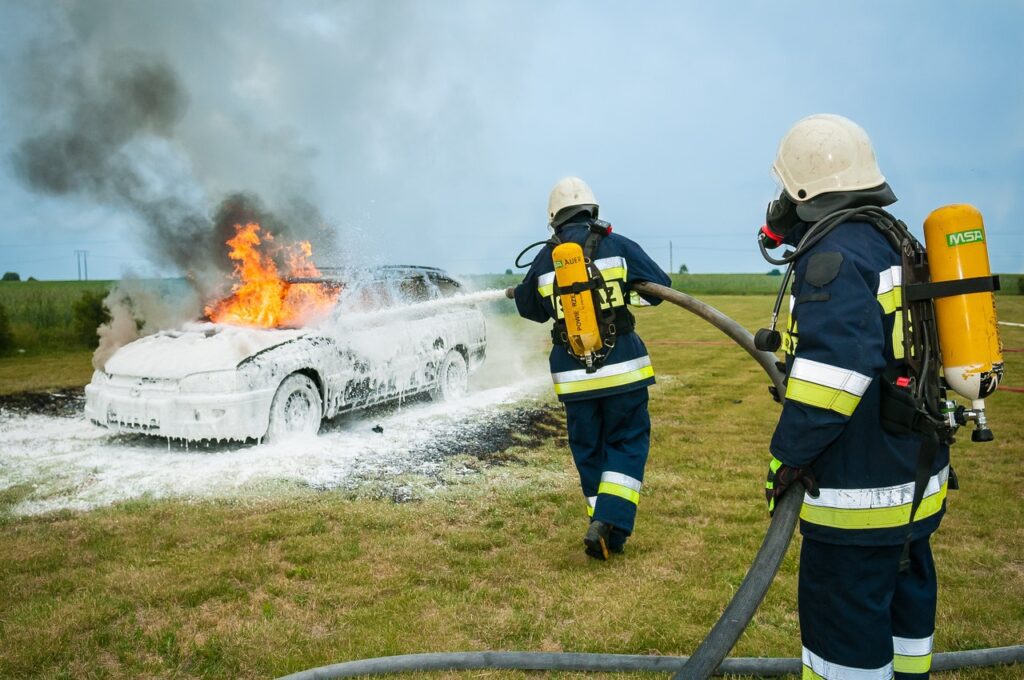
For Class A and Class B fires, foam fire extinguishers can be used to put out the flames. Water jet extinguishers can only extinguish liquid fires like gasoline or fuel, whereas foam extinguishers can extinguish solid fires like wood and paper. Flame retardant foam can be used to extinguish liquid fires by preventing flammable vapor from reaching the air and therefore denying the fire fuel. Flowing liquid fires cannot be controlled with foam extinguishers.
There is a cream-colored label on foam extinguishers.
Powder Extinguishers
As they work on Class A, B, and C fires, powder extinguishers make excellent all-purpose extinguishers. Even while they can be employed to put out electrical equipment fires, their cooling effect leaves the fire vulnerable to re-ignition. In addition to reducing visibility, powder extinguishers may potentially cause respiratory issues. However, unless there is no other option, they should not be used inside structures.
The label on powder extinguishers is blue.
CO2 Fire Extinguisher
In situations where there is a lot of electrical equipment, carbon dioxide extinguishers (CO2) are ideal since they are safe to use on fires involving electrical machinery. In contrast to foam extinguishers, carbon dioxide extinguishers don’t leave behind any residue. On class B fires, such as those that involve flammable liquids like paraffin or gasoline, they can also be employed. CO2 extinguishers function by suffocating the fire and shutting off the flow of air, thus putting out the flames.
Wet Chemical Extinguisher
Class F fires containing cooking oils and fats, such as lard, olive oil, sunflower oil, maize oil, and butter, can be put out with wet chemical extinguishers. When employed correctly, they can be immensely powerful. Using a soap-like solution, the wet chemical quickly extinguishes the fire, cools the burning oil, and seals the surface to prevent re-ignition. Class F fires, including fires caused by cooking oils and deep fat fryers, can be extinguished using this extinguisher.
Yellow is the color of the label on wet chemical extinguishers.
Fire Blanket
Hot oil flames such as frying pans and small deep fat fryers can be extinguished with fire blankets. They can also be used to put out a fire started by a person’s clothing. To put out the fire, they suffocate it, blocking the oxygen supply that is feeding it.
Operation of Fire Extinguishers
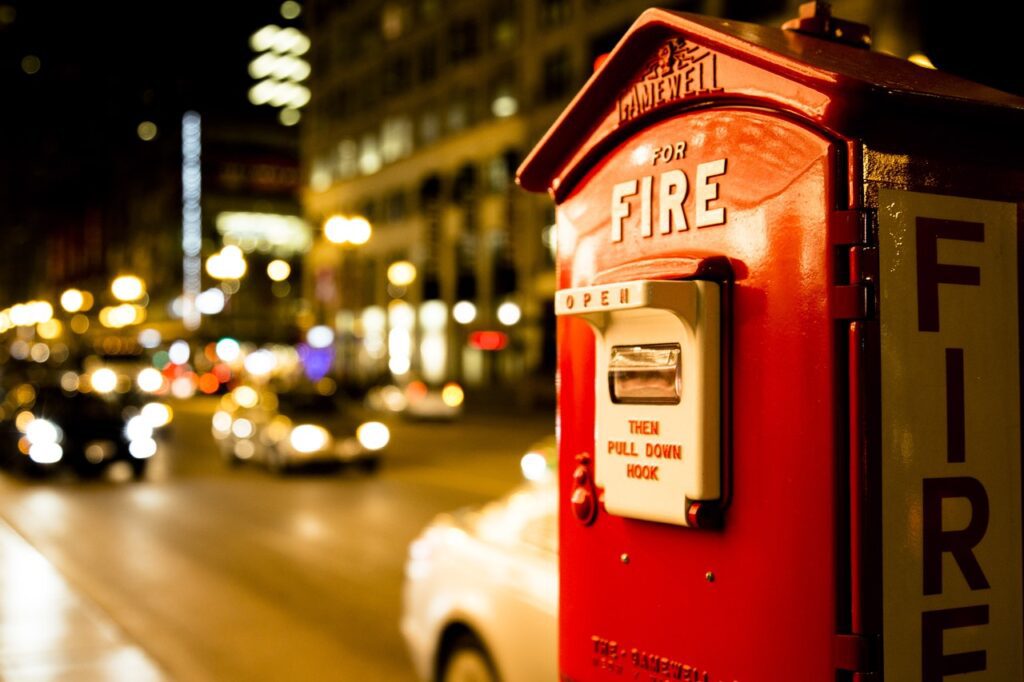
You must know how to use a fire extinguisher in the event of a fire. In a fire emergency, being confident in how to use it is necessary. Make sure you have the correct sort of fire extinguisher on hand before you need to use one. Fire extinguishers should only be used by people who have been educated in their proper use.
It’s always best to seek outside assistance while trying to put out a fire on your own. A fire may get out of hand faster than you expect. Help on the way is a good idea.
Before approaching the fire, plan an evacuation route. No matter how dangerous it may be, let nothing stand between you and your evacuation route.
To use the PASS Method, one must first learn how.
- Pull the pin: The operational lever should unlock when you pull the pin, allowing you to discharge the extinguisher.
- Aim low – point the hose/nozzle of the fire extinguisher at the fire’s source.
- Squeeze the lever – the extinguishing agent should be discharged as a result of this. A button or other mechanism of activation may be found on certain extinguishers.
- Sweep from side to side—you should sweep back and forth until the fire is out while aiming towards the base of the flames. Restart the process if the fire re-ignites.
Additional Safeguards to Keep in Mind Include:
- Maintaining your back to an exit will ensure that you have a feasible way out of the fire.
- Start PASS at least 8 feet away from the fire.
- Leave the fire if it doesn’t go out right away.
- It’s best to have the local fire department do a thorough investigation to make sure the fire has been completely extinguished and that no hidden hot spots remain.
- Recharging or replacing an extinguisher is required if it is used at all (even partially).
How to Maintain Fire Extinguishers
- To ensure that the extinguisher does not become obstructed by furniture, doors, or anything else that could impede access in the event of an emergency, it should be checked frequently.
- Check whether the pressure is just right and check the extinguisher’s gauge periodically.
- Do fire extinguisher inspection timely.
What to Do in an Emergency Fire Accident?
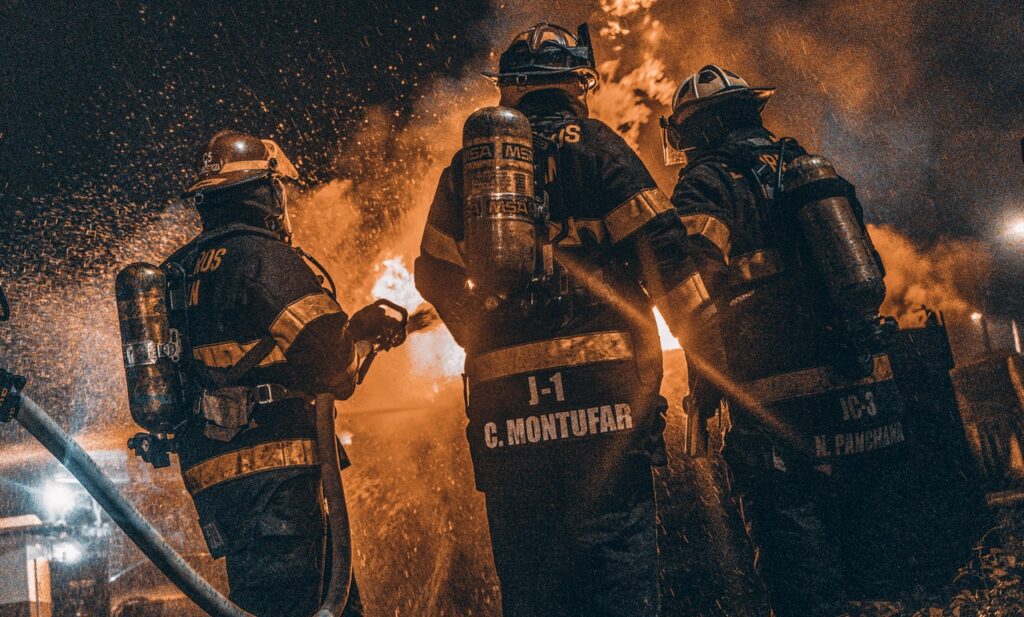
- Call the fire department personally or have someone else do it for you. First and foremost, have everyone leave the building. Once the victim is outdoors and safe, have a friend or family member phone the fire department. In the event of an emergency, even if you think you can put out the fire on your own, it’s preferable to call the fire department. Firefighters can verify that the fire has been extinguished correctly when they arrive on the scene. Even if something appears secure, this does not imply that it is.
- Turn your back on the nearest exit. Take a few safety steps before you use a fire extinguisher to suppress a fire. Position yourself so that your back is facing the exit you’ve identified as the closest one. When an emergency arises, it will be easy for you to get out of the building in a matter of seconds.
- To avoid becoming lost or confused, always keep your back toward the exit.
- Set your distance correctly. Fire extinguishers with a range of 8 to 12 feet are the most common (2.4 to 3.7 m). Move 6 to 8 feet (1.8 to 2.4 meters) away from the fire before using the extinguisher, depending on how close or far away you are from the fire. Once the fire has been extinguished, you can get closer.
- Release the latch. A pin put into the handle of every fire extinguisher prevents the discharge of the fire extinguisher by accident. Pull the pin out of the handle by grabbing the ring and pulling it out of the handle’s side. Hold the extinguisher so that the nozzle is pointing away from you now that it is ready to discharge.
- A zip tie on the pin of fire extinguishers in non-residential or high-density residential regions may be used to alert the fire service that the extinguisher has been used. To be easily broken, the zip tie was designed in this way.
- Put water on the fire by aiming the hose at the source. Make sure you have both hands free to grip the hose or nozzle. As you need to extinguish the burning fuel, aim the hose at the bottom of the flames.
- Keep your hands away from the plastic discharge horn of carbon dioxide extinguishers, which gets extremely cold.
- Pull the lever to the side. One hand should be used to pull back on the two levers while the other is used to direct water toward the fire’s origin. When squeezing the levers, apply even and slow pressure. The extinguisher can be stopped by releasing the levers.
- Use a side-to-side motion with the hose. Sweep the hose back and forth over the fire’s base as you discharge the extinguisher to ensure that all of the fuel is extinguished. As the fire dies down, move closer to it.
- Keep going until the fire is extinguished. This includes any embers that may re-light.
- If the flames start to spread, move back and try again. Keep an eye on the flames to make sure they don’t re-ignite. If they do, you should slightly retreat. To put out the fire, re-aim the hose, squeeze the lever, and sweep the hose across the fire’s base.
- A fire should never be turned away from. You should always keep an eye on where the fire is and what it’s up to at any given time.
- Your fire extinguisher should be replaced or recharged as quickly as feasible. Disposable fire extinguishers must be thrown away after use because they are no longer useful. Some can be refilled with agents and re-pressurized, while others are rechargeable.
- In case of an emergency, make sure no one is trying to use an empty fire extinguisher.
- If it’s rechargeable, recharge your fire extinguisher as soon as possible. If you delay, you run the risk of being unable to use your fire extinguisher in the event of an emergency.
- If you can’t put out the fire, get out of there right away. Despite your best efforts, if you are unable to put out the flames, you should evacuate the area and reach a safer place.
Fire can occur at any moment and in any location. It is essential for individuals sharing a building area to feel safe. The problem of fire protection is multifaceted. TAS Fire Protection delivers unrivalled, uncompromising quality in terms of efficient systems, equipment, up-to-date knowledge, and skills. Contact TAS Fire for fire inspection services Canada , offers a variety of products and services to customers to help them live a life without fire accidents.
Our Products and Services
Contact Us (905-870-7779) for a Free Consultation!
—
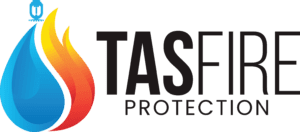
About TAS Fire Protection
TAS Fire Protection offers comprehensive and cutting-edge fire protection and security services to commercial, industrial, and high-rise properties. Our team of highly skilled professionals has years of experience in installing, maintaining, and inspecting fire alarm systems, fire sprinkler systems, fire extinguishers, fire hydrants, security alarm systems, and more. We understand that fire safety and security is essential to the protection of lives and property.
> Learn More
